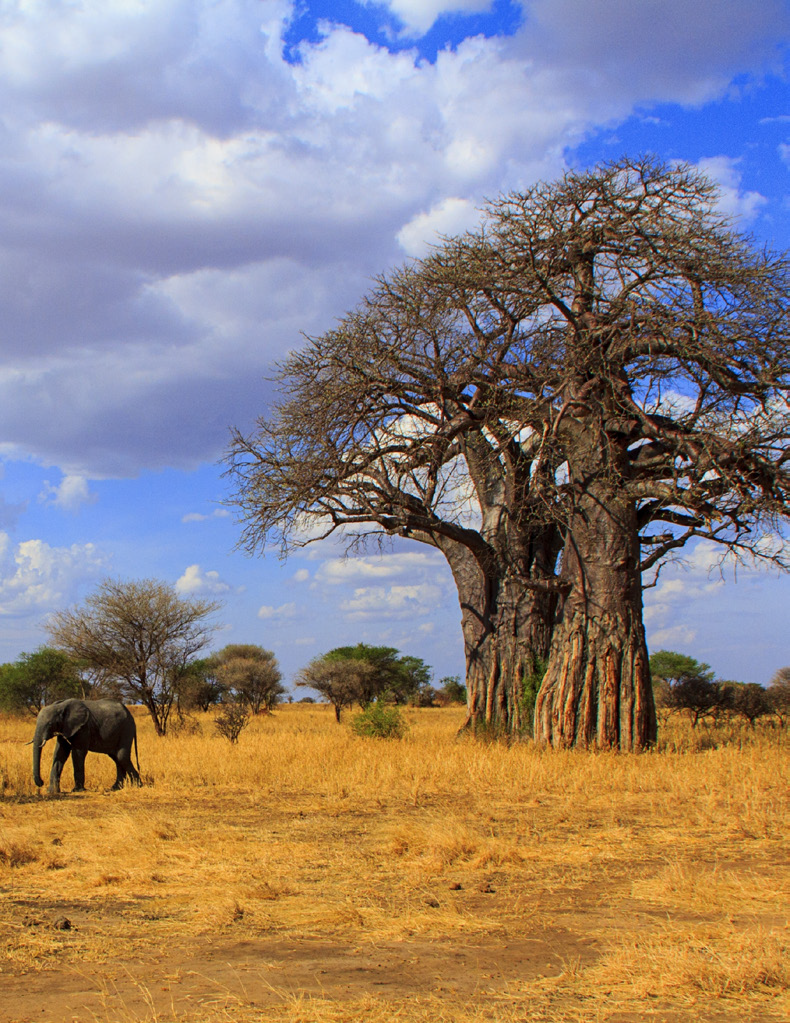The iconic Baobab tree is famously known as the “Tree of Life” because of the multiplicity of its life serving functions. It is also known as “Elephant Tree” due to its enormous physical appearance. Adonsonia digitata is the most common species of Baobab found in Africa.
Southern African countries including Zimbabwe, South Africa, Botswana, Zambia, and Madagascar are endowed with a variety of Baobab tree species. Zimbabwe and Zambia are examples of countries where the baobab tree has contributed to the enhancement of people’s livelihoods.
The Baobab is a flagship tree species across many ethnical and cultural groups in Southern Africa. However, the major area of concern pertains to the different laws governing the protection and conservation of natural resources in rural communities. Since time immemorial, traditional systems used to be the governing rules behind the conservation of baobab trees.
Nevertheless, the enactment of statutory instruments under national laws further strengthened the already existing traditional laws on natural resources conservation. Research has also revealed myths and traditional systems governing the Baobab in Southern Africa as a way of protecting them against the commercial demand of its products.
Zimbabwe is an example of a country where customary laws and statutory instruments coexisting known as Dual Governance. The government realized that baobab tree presents huge opportunities in the development of people’s livelihoods especially in rural communities. This has seen the Baobab classified as one of the few tree species regulated by dual governance. Dual governance is when national laws empower traditional leaders to play an oversight role in the management and conservation of natural resources in their respective communal areas. This upholds norms and values of a particular community.
According Amkela Sidange, Environmental Management Agency (EMA) Spokesperson the Statutory laws gives a broad framework on how local communities manage their natural resources. “Some pieces of governance include SI 61 of 2009 Environmental Management (Access to Genetic Resources and Indigenous Genetic-Resource based Knowledge) regulations 2009, Traditional Leaders Act and Forestry Produce Act,” she said. These frameworks provides for the conservation and sustainable use of all natural resources. This also gives communities the rights to access and enjoy the benefits of country’s biodiversity.
The statutory laws have given absolute powers to local leaders to play an oversight role in governing natural resources with the assistance of Rural District Offices. The Traditional Leadership Act Chapter 29: 13- empowers traditional leaders to participate actively in the conservation of all natural resources that fall within their jurisdiction and Act No 25 Confers a wide range of powers on traditional leaders.
Lewis Radzire, Forestry Commission Operations Manager confirmed the existence of Statutory Instrument governing natural resources. “We have Statutory Instrument 116 of 2012 and Communal Land Forest Produce Act. These are the main two pieces of legislation.” In line with this, the Communal Lands Forest Produce Act No 37 Sets up the Forestry Commission as the regulatory authority which grants permits to all timber and non- timber forest product harvesters.
The Green Business Gazette crew visited the South Western parts of Zimbabwe during the month of July this year. Ethnic tribes in Esigodini and Beit Bridge communal areas are still bound by the traditional myths that govern what they regard as elephant tree. These play an important role in the regulation of the use of Non-Timber Forest Products. Sibongile Hlatshwayo, a 26 year old married woman of the Venda origin and from Esigodini told this news crew that the tree carried high esteemed value in the area.
Access to the Baobab tree is also regulated. External migrants wishing to access the baobab are expected to first seek permission from traditional leader. Failure to adhere to the traditional laws will attract penalties and sanctions. “We still believe that our baobab trees are still secretive and there are certain norms and values which are supposed to be followed by both locals and externals coming to access baobab products. Failure to observe the norms will see visitors exposed to untold mysterious sufferings, the likes of getting lost in the forest, sickness and sometimes coming across a rare animal,” Hlatswayo said.
Apart from this, the Venda and Suthu tribes in the south western region believe that the baobab tree has certain mythical properties that can make a woman conceive many children. What was usually done to girls before entering into marriage was that they were made to sit in a kraal encircled by baobab trees. “Sometimes we were told to sit inside a kraal surrounded by many baobabs and this was done for us to have many children without complications. This is derived from the view that the baobab is the only tree species which survives for many years during both dry and rainy conditions,” she added. Various research projects have suggested that the Iconic baobab species have a life span of up to 5000 years.
Researches have also revealed that the Tonga people in Zambezi and the Gumbu clan in modern day Buhera (Vahera) believes that the baobab tree through its enormous shadow provides spiritual rest to the dead. A traditional headman from Buhera commented on condition of anonymity and confirmed the spiritual uses of the baobab tree in his community. “The baobab is a sacred tree. We have a number of places which I cannot reveal to the public that are burial sites. Our ancestors told us that the Baobab shadow is spiritual and therefore provides a resting place for the dead. This explains many reasons why it is rare for one to encounter a ghost during the night,” he said.
“Externals wishing to visit baobabs either for tourism purposes or trade intentions, are expected to seek permission first from us traditional leaders so that they may not face problems during the course of touring. Failure to respect these norms and values of our land or committing what is forbidden in the area surrounding baobabs by both externals and local people results in suffering spiritual turmoil. Some will suffer from memory loss on the direction of where they are going. One can encounter a large baboon or a large scaring snakes like African python (Python sebae) and Black-mamba (Dendroaspis polylepis) as a sign of disapproval. When one transgresses the laws of the land, they will have to visit the local traditional leader in order to be forgiven, which takes place after paying either a goat or money depending on the extent of transgression ’’ revealed the traditional headman.
“This would require one to first visit the local traditional leader to cast an apology. This will be done after paying either a goat or cattle and sometimes money. However, if one refuses all these they will face a death punishment,” he added. The Tonga people encamped in the Lower Zambezi both in Zimbabwe and Zambia believe that during pre-historic times, the tree was created upright and proud, but later dominated other surroundings. This made gods to become angry and uprooted it and replanted it upside down.
Besides the cultural value of the Baobab species, the tree holds a commercial value and significantly contributes to local economies at both household and community levels. There is a great potential for the tourism sector in the baobab and its products which can are sold as curios. . This pertains to both domestic and International tourism business sectors. Zimbabwe’s Elephant Hills in Victoria Falls has unique baobab trees located in front of the resort hotel. South Africa’s Musina is also identified by a gigantic baobab as most travellers usually visit it for photo shoots. The Avenue of Baobab lines in Madagascar has become an epitome of a tourism hub inspiring visitors from Africa and the Globe to visit the majestic area.
There are high chances of external people developing keen interest to visit places where people bear testimonies to baobab mythical properties. A good number of tourists who have tasted the products will surely find it interesting to visit the sources of the non-timber products. History has it that Gumbu clan from modern day Buhera were into craft making businesses where they would make fibre bags from the bark of the baobab tree.
The Baobab fruits have nutritional value and Communities have been making use of the fruit which contains Vitamin C, Potassium, Carbohydrates and Phosphorus. The local trade has been helping to enhance the livelihoods across societies. Most people from Mashonaland area in Guruve earn a living from selling (Mauyu) baobab fruits. These are usually delivered to the Capital City for enhancement of local trade. Recently commercialisation of baobab fruit juice has made it a delicacy in urban centres. Both young and old folks admire the baobab.
The baobab pulp has in the past two decades created ready market in the USA due the fact that baobab presents edible fruits which contain various nutrients needed in the European Markets, Canada and United States of America (USA).

Through its medicinal properties, the baobab tree plays a very crucial role to the health of rural communities in Sub-Saharan Africa where access to health services is limited and they resort the tree or purchase baobab medicinal products at local markets (Musika). The most prominent baobab products include its powder, salad supplements among other essentials. It is believed that the product is needed in the developed nations due to its natural health ingredients. These include improving digestion, supporting immune system, general hydration and skin health. Apart from this, it is said to have antioxidant properties which are useful to prevent anaemia and asthmatic diseases. The United States of America (USA) Food and Drug Administration (FDA) in 2009 certified the baobab’s products. Other medicinal properties needed by the USA residents include loss weight programs which have benefited many people. Baobab trees have been presenting a lot of opportunities in Tourism Industry.



